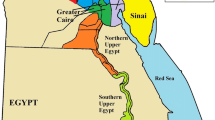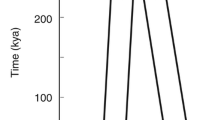Abstract
STR loci are becoming increasingly important in forensic casework. In order to be used fairly and efficiently, the population genetics of these loci must be investigated and the implications for forensic inference assessed. A key population genetics parameter is the “coancestry coefficient”, orF ST, which is the correlation between two genes sampled from distinct individuals within a subpopulation. We present analyses of STR data, at geographic scales which range from national to regional, from the UK and other European sources. We implement a likelihood-based method of estimating FST, which has important advantages over alternative methods: it allows a range of plausible values to be assessed, rather than presenting a single point estimate, and it allows a subpopulation to be compared with a larger population from which a database has been drawn, which is the relevant comparison in forensic work. Our results suggest that values ofF ST appropriate to forensic applications in Europe are too large to be ignored. With appropriate allowance, however, it is possible to make use of STR evidence in a way which is efficient yet avoids overstatement of evidential strength.
Similar content being viewed by others
References
Ammerman AJ, Cavalli-Sforza LL (1984) The neolithic transition and the genetics of populations in Europe. Princetown University Press, Princetown NJ
Balding DJ, Donnelly P (1995) Inference in forensic identification. J R Stat Soc A 158: 21–53
Balding DJ, Nichols RA (1994) DNA profile match probability calculation: how to allow for population stratification, relatedness, database selection and single bands. Forensic Sci Int 64: 125–140
Balding DJ, Nichols RA (1995) A method for quantifying differentiation between populations at multi-allelic loci and its implications for investigating identity and paternity. Genetica 96: 3–12
Barbujani G (1991) What do languages tell us about human microevolution? Trends Ecol Evol 6: 151–156
Barbujani G, Sokal RR (1991) Genetic population structure of Italy 11: physical and cultural barriers to gene flow. Am J Hum Genet 48: 398–411
Budowle B (1995) The effects of inbreeding on DNA profile frequency estimates using PCR-based loci. Genetica 96: 21–25
Cavalli-Sforza LL, Feldman M (1990) Spatial subdivisions of populations and estimates of genetic variation. Theor Popul Biol 37: 3–25
Cavalli-Sforza LL, Menozzi P, Piazza A (1995). The history and geography of human genes. Princeton University Press, Princeton, NJ
Donnelly P (1996) Interpreting genetic variability: the effects of shared evolutionary history. In: Weiss K (ed) Variation in the human genome. Wiley, New York (in press)
Gill P, Evett I (1995) Population genetics of short tandem repeat (STR) loci. Genetica 96: 69–87
Hammond HA, Jin L, Zhong Y, Caskey CT Chakraborty R. (1994) Evaluation of 13 short tandem repeat loci for use in personal identification applications. Am J Hum Genet 55: 175–189
Kimpton CP, Fisher D, Watson S, Adam M, Urquhart A, Lygo JE, Gill P (1994) Evaluation of an automated DNA profiling system employing multiplex amplification of four tetrameric STR loci. Int J Legal Med 106: 302–311
Metropolis N, Rosenbluth AW, Rosenbluth MN, Teller AH, Teller E (1953) Equation of state calculations by fast computing machines. Chem Phys 21: 1087
Morton NE (1993) Kinship bioassay on hypervariable loci in blacks and caucasians. Proc Natl Acad Sci USA 90:1892–1896
National Research Council (1992) DNA technology in forensic science: theory, techniques and applications. National Academy Press, Washington DC
Nichols RA (1995) How large are the relevant genetic correlations. Comment on “Inference in forensic identification”. D.J. Balding & P. Donnelly. J R Stat Soc A 158: 2153
Nichols RA, Balding DJ (1991) Effects of population structure on DNA fingerprint analysis in forensic science. Heredity 66: 297–302
Slatkin M (1985) Gene flow in natural populations. Ann Rev Ecol Syst 16: 393–430
Slatkin M, Barton NH (1989) A comparison of 3 indirect methods for estimating average levels of gene flow. Evolution 43: 1349–1368
Smith AFM, Roberts GO (1993) Bayesian computation via the Gibbs sampler and related Markov chain Monte Carlo methods. J R Stat Soc B 55: 3–24
Takahata N (1983) Gene identity and genetic differentiation of populations in the finite island model. Genetics 104: 497–512
Weber JL, Wong C (1993) Mutation of human short tandem repeats. Hum Mol Genet 2: 1123–1128
Author information
Authors and Affiliations
Rights and permissions
About this article
Cite this article
Balding, D.J., Greenhalgh, M. & Nichols, R.A. Population genetics of STR loci in Caucasians. Int J Leg Med 108, 300–305 (1996). https://doi.org/10.1007/BF02432124
Received:
Revised:
Issue Date:
DOI: https://doi.org/10.1007/BF02432124




